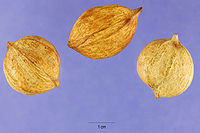
Photo from wikipedia
Paper description: The hard-to-root property of white poplar hardwood cuttings is one of the principal problems in white poplar nursery production. This research analyses vegetative propagation by hardwood cuttings of… Click to show full abstract
Paper description: The hard-to-root property of white poplar hardwood cuttings is one of the principal problems in white poplar nursery production. This research analyses vegetative propagation by hardwood cuttings of four genotypes of white poplar and the variability of 14 morphometric characteristics of cuttings’ rooting, the relation between them and the effect of various technological treatments formed as a combination of applications of powder formulations of indole butyric acid and foliar treatment with urea solution. This study points to significant differences in the rooting and survival of cuttings of white poplar genotypes, but weaker disparities between examined technological and interaction treatments. Abstract: White poplar is a key species in wood production and afforestation, but also very important for biodiversity preservation and habitat improvement. Vegetative propagation from hardwood cuttings is the most desirable method of white poplar breeding. The present research analyzed the effect of various technological treatments on four white poplar clones. Selected treatments were powder formulations of indole butyric acid (IBA) and foliar treatment with urea. The variability of 14 morphometric characteristics on the rooting of cuttings was analyzed, as well as relationships between them. Differences in analyzed morphometric characteristics depended on genotype, while the effect of the examined technological treatments was detected only by Fisher’s least significant difference (LSD) test. Significant variability between genotypes was found for traits describing rooting at the basal cut (R0 and R0p), the number of leaves (LN), the total number of roots (TRN), and cutting survival in the first part of the growing season (SURV07). Application of IBA had significant stimulating effects on rooting at the lower part of cuttings (R05) compared to controls. Variability between genotypes after foliar treatment with urea was not detected. The examined parameters were grouped into 5 groups by principal component analysis, where shoot traits and traits that describe rooting at the basal cut were in the same group with total number of roots, and cutting survival (SURV07) was in a separate group. These results suggest a need for further testing of the characteristics of hardwood cuttings in white poplars. More efficient clone technology is needed, using auxins and/or nitrogen fertilization designed to suit the specific requirements of particular clones. https://doi.org/10.2298/ABS200114008I Received: January 14, 2020; Revised: January 28, 2020; Accepted: February 20, 2020; Published online: February 24, 2020 How to cite this article: Igic D, Borisev M, Vilotic D, Sijacic-Nikolic M, Cuk M, Ilic M, Kovacevic B. Variability and relationships among rooting characteristics for white poplar hardwood cuttings . Arch Biol Sci. 2020;72(2):153-63.
Journal Title: Archives of Biological Sciences
Year Published: 2020
Link to full text (if available)
Share on Social Media: Sign Up to like & get
recommendations!